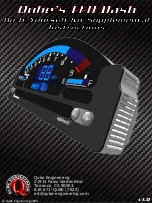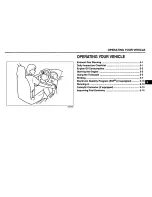
When foot brake pedal is depressed
Being pushed by the operating rod, the booster
air valve moves to the left as shown. Then the
control valve is pushed against the booster
piston seat closely by the valve spring force.
Thus the vacuum valve (control valve
is closed to cut off between the chambers “A”
and “B”. At this time the air valve (control valve
“D”) is still closed.
Booster control valve
2.
Booster air valve
3. Booster piston
Fig. 19-14-1
As the booster air valve moves further to the
left, it leaves the control valve and the air valve
(control valve “D”) opens to allow the air to
flow into the chamber “B”. The entry of air
causes a difference in pressures between the
chambers “A” and “B” When this pressure
difference grows greater than the piston return
spring force, the booster piston moves to the left
and the booster control valve also moves to the
left. The resulting air valve (control valve “D”)
closure stops the air flow into the chamber “B”
and its pressure remains as it is. In this way, a
small brake pedal depressing force is made into
a strong push to the master cylinder push rod to
produce high hydraulic pressure.
Vacuum valve
Control valve
1. Booster control valve
2. Booster air valve
3. Booster piston
Fig. 19-14-2
When foot brake pedal is released
When the brake pedal is released, the booster air
valve returns to the right by the master cylinder
piston return force and the air valve return
spring force as shown. Then the vacuum valve
(control valve “C”) opens and causes negative
pressure in the chamber “B”. The result is that
the master cylinder piston and booster piston
return to their original positions. This is the
same state as described under “When foot brake
pedal is not depressed”.
Fig. 19-14-3
2. Air valve return spring
3. Booster piston
4. Booster control valve
Reference
Should any of the vacuum related parts in the
booster be faulty, the brake force is not increas-
ed. Even then, however, the brake depressing
force is transmitted to the valve operating rod,
booster air valve, valve stopper key and booster
piston in that order, to push the master cylinder
push rod. Thus, the braking operation itself will
Fig. 19-14-4
19-13
Summary of Contents for Samurai 1986
Page 1: ......
Page 9: ...0 9...
Page 10: ...0 6...
Page 11: ...0 7...
Page 12: ...0 8...
Page 13: ...0 9...
Page 14: ...0 10...
Page 15: ...0 11...
Page 19: ...1 2...
Page 20: ...1 3...
Page 119: ...r a l I 29 Fig 4 1 1 Carburetor exploded view 4 3...
Page 120: ...N Fig 4 l 2 Carburetor cross section 4 4...
Page 154: ......
Page 155: ...T c c x 5 5 3...
Page 347: ...Fig 17 1 34 17 12...
Page 348: ...17 13...
Page 353: ...Fig 17 2 12 17 18...
Page 354: ...17 19...
Page 360: ...Fig 17 3 19 Fig 17 3 20 Fig 17 3 21 5 Fig 17 3 23 Ci Fig 17 3 24 Fig 17 3 22 17 25...
Page 424: ...Fig 19 6 1 19 38 19 6 PARKING BRAKE...
Page 448: ...20 13...
Page 450: ...21 2...
Page 475: ...22 5...
Page 476: ...22 6...
Page 477: ...22 7...
Page 478: ...22 8...
Page 479: ...22 9...
Page 480: ......
Page 481: ......
















































